Cultural Tourism
WONDERS BETWEEN HISTORY AND CULTURE
Not only sea and food&wine excellence: a vacation in Apulia is also history and culture, thanks to the many museums and archaeological sites present across the area.
UNESCO Sites
Leaving from Taranto, in one day it is possible to visit, just a few kilometres away, some of the most important UNESCO World Heritage Sites.
Castel del Monte - Andria (BAT)
Andria (BAT): symbol of the union between the various cultural elements hailing from northern Europe, from the Muslim world and from classical antiquity, it is a unique masterpiece of medieval architecture, since 1996 in the UNESCO World Heritage List and one of the many museums that belong to the Regional Management of Museums (discover more).
The Castle, located in the countryside of Andria, dates back to the thirteenth century and was commissioned by Frederick II of Swabia, emperor of the Swabian dynasty and at the same time descendant of the Norman kings of southern Italy, as son of Henry VI of Swabia and Constance of Altavilla.
The building, in addition to being an example of accurate and strategic construction with octagonal structure, has a mysterious symbolism that fascinates scholars and visitors, so much so that it is one of the thirty most visited Italian state sites.

Alberobello
The trulli, the typical limestone homes in Alberobello in southern Puglia, are extraordinary examples of dry stone slab construction, a technique dating back to prehistoric times and still used in this region. Even though the trulli are scattered throughout the Itria Valley, the highest concentration of the best preserved examples of this architectural style can be found in the town of Alberobello, with more than 1500 structures in the districts of Monti and Aja Piccola. In 1620, the settlement began its expansion. In 1797, towards the end of feudal rule, the name Alberobello was adopted, and Ferdinand IV of Bourbon, King of Naples, gave the town the title of royal city. Between 1909 and 1936, some parts of Alberobello were declared protected monuments of cultural heritage.
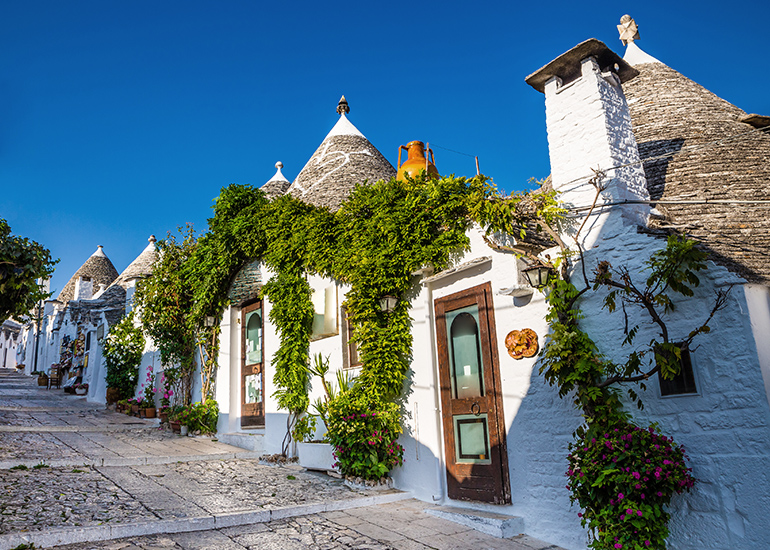
Matera
Matera historically was part of Apulia and was included in the land of Otranto until 1923. It is located in Basilicata a few kilometres away from Taranto. The World Heritage site includes Sassi and the Park of the Chiese Rupestri, a complex of houses, churches, monasteries and hermitages built in the natural caves of the Murgia, a limestone plateau characterised by deep cracks, ravines, rocks and caves.
The homes in the two Sassi of Matera, the Caveoso and Barisano, surround the Civita, the oldest part of the city, which is located in the highest point.
The Park of the Chiese Rupestri includes over 150 examples of chiese in rupe (churches on the rock), often frescoed or with bas-relief, a heritage of sacred art that demonstrates the various historical and cultural periods of the area.
Among the Chiese Rupestri there is the “Crypt of Original Sin” considered the Sistine Chapel of the rock churches, which contains a pictorial cycle of the ninth or tenth century with strong similarities to the Longobard painting tradition of Benevento.

FAI in Puglia
The Abbey of Santa Maria di Cerrate
The monastery dates back to the late eleventh and early twelfth century and is attributed to Boemondo d’Altavilla – son of Robert Guiscard – and protagonist of the first crusade. The abbey, which was a centre of dissemination of Italo-Greek culture in Salento, gradually lost importance until it was transformed into a private estate. After being recovered as public heritage, in 2012 the complex was entrusted by the Province of Lecce to the Italian Environmental Fund.
Today, after a complex restoration that also allowed the reopening of the Church of Santa Maria di Cerrate to the faithful, the abbey can be visited again and represents a splendid example of Apulian Romanesque architecture embellished by frescoes that make it unique in the Byzantine world .
(source: www.fondoambiente.it)

Taranto surroundings
The rocky cities and the ravines: Laterza, Ginosa, Mottola, Massafra, Castellaneta, Crispiano, and Grottaglie
Taranto surroundings allow exploring lesser known areas but of extreme charm.
Many of the cities of the Ionian province have a rocky base, that is, they were formed by hamlets whose churches and homes were not built but obtained from ravines and rocky terrains. Later, some of these incredible medieval villages received a castle – generally from the eleventh century with the Norman rule – and expanded into the striking architecture of the Mediterranean area. In the abandoned hamlets, instead, life seems stopped in the Middle Ages. It is possible to visit many rock churches decorated with Byzantine style frescoes, mostly dating back to the twelfth and thirteenth centuries, showing saints of oriental and crusader tradition, and also Christian scenes of high theological and interpretative complexity that are directly linked to the Constantinople royal court.
In the towns of Ginosa, Laterza, Castellaneta, Mottola, Massafra, Crispiano and Grottaglie, municipalities, associations and experts offers excursions in the ravines, which are also a naturalistic and landscape habitat unique in the world.
In Crispiano it is also possible to visit the “masserie” traditional farms with a varied and complex architecture, nestled in the green landscape of the Taranto Murgia.

The cities of ceramics
Laterza and Grottaglie are also cities of ancient ceramic tradition, linked to the production of refined majolicas. Both host very interesting museums of ceramics. In Grottaglie, the ceramics district allows you to visit and shop directly in the ancient artisan stores, some of which preserve the original furnaces and are hosted in hypogeal rooms and old oil mills.
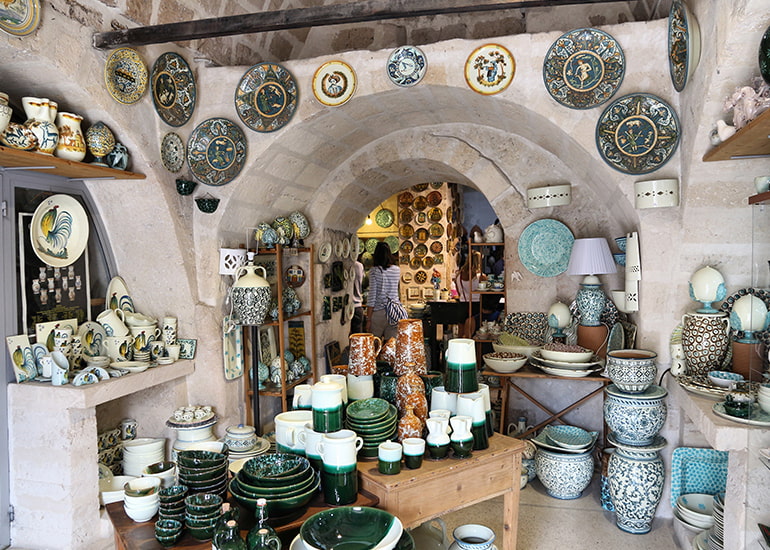
The Baroque and Itria Valley: Martina franca
Founded in 1310 by the Angevins who joined three pre-existing hamlets, still traceable in its urban structure, over the centuries the city became the centre of a rich area and strategically located between the Ionian and Adriatic seas. With the dukedom of Petracone Caracciolo, in the eighteenth century the city received a monumental boost with the construction, on the pre-existing buildings, of the ducal palace in Baroque style like the one of the great basilica of San Martino and many noble palaces.

Between Greeks and Messapians
Manduria
Taranto is the starting point for other pleasant excursions.
The one to Manduria is particularly charming. This important city preserves large parts of the Messapian walls, under which the Spartan king Archidamo lost his life in 344/342 B.C. and where, in addition to the park of the walls and the necropolis, it is possible to visit the Fonte Pliniano, so called because it was described by Pliny the Elder as well as the early medieval church of San Pietro Mandurino, the museum and the beautiful old town.
Manduria is also a renowned wine city, because of the excellence of its Primitivo wine, and many wineries can be visited.

Oria
Oria is also a city of Messapian origin, mentioned in ancient sources as the headquarters of a “dynast”.
Recent archaeological researches brought to light urban structures and sanctuaries, which can be partially visited as well as the new museum. The city is also linked to the name of Frederick II of Swabia, who, in order to enjoy hunting in the great forest of Oria, built his own castle in the highest part of the urban centre, which was literally moved to the foot of his residence.
The Jewish community of Oria is famous and since the ninth century it has been an important element of the cultural life of the area.
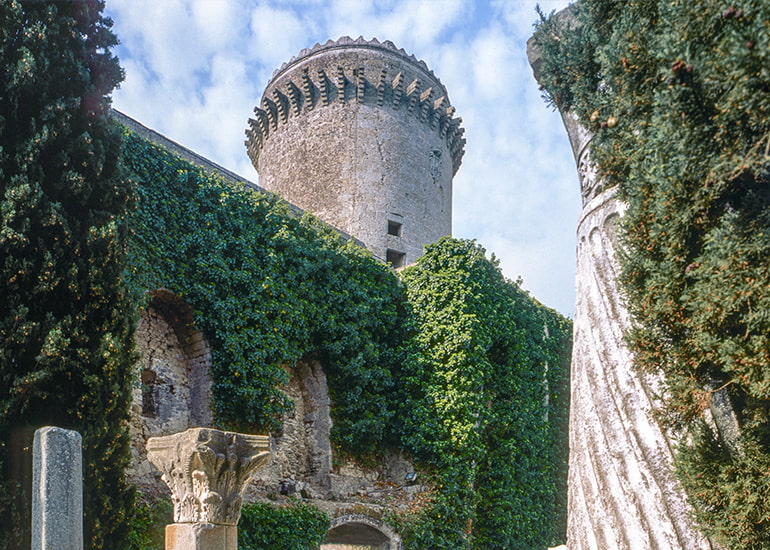
Archaeological area Muro Tenente
Between the municipalities of Latiano and Mesagne, we recommend a visit to the archaeological area Muro Tenente. The archaeological park made possible the discovery, through excavations and a constant research and valorisation activity, a Messapian and then Roman city, identified with the ancient Scamnum of the Roman Itineraries, located along the route of the Via Appia Antica. The ancient city is still surrounded by the ruins of the walls and archaeological excavations that brought to light the necropolis, sacred areas and blocks of houses, where a Messapian house was reconstructed with philological accuracy following the archaeological data.
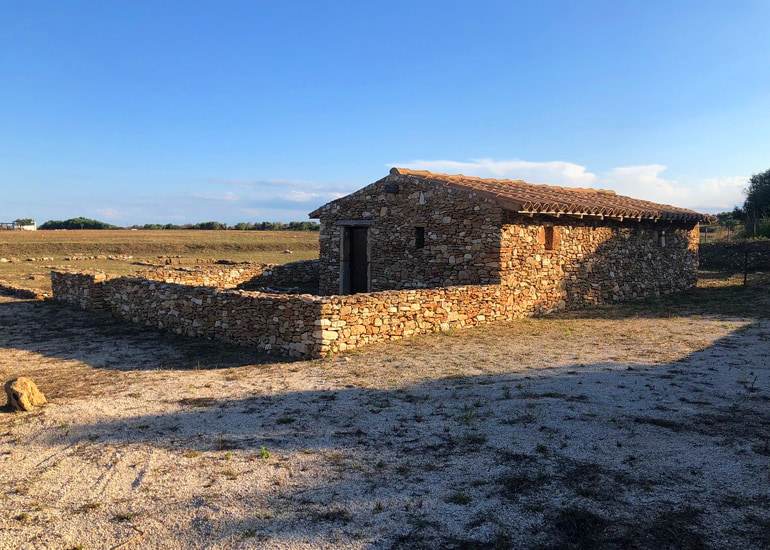
Mesagne
Mesagne, a few kilometres away from Muro Tenente, can be reached through minor roads that follow the ancient via Appia. Its historical centre is very beautiful in late Baroque style, but there are also medieval and Roman districts, such as the area of vico Quercia, which can be visited, and the Archaeological Museum located in the castle where you can admire a reconstructed Messapian chamber tomb.

San Pietro di Crepacore Masseria Li Turri farm house
The building, found in the Masseria “Li Turri” is located along the road that leads from Mesagne to Torre S. Susanna. There is a small church with two domes aligned that is wonderful for its monumentality and the fact that it is built in part with megalithic blocks and other reused elements from the Roman villa that in the imperial age stood here. The church, which had to be part of a hamlet, dates back to the seventh century A.D. and preserves inside very complex and refined Byzantine frescoes, with inscriptions in Greek that refer to calligraphic characters from Constantinople, while the type of the church is of Longobard origin: after all, we are in the vicinity of the Limitone dei Greci, a large dry-stone wall, coeval to the church of San Pietro, which marked the border between Longobardia Minor and the Byzantine Empire.
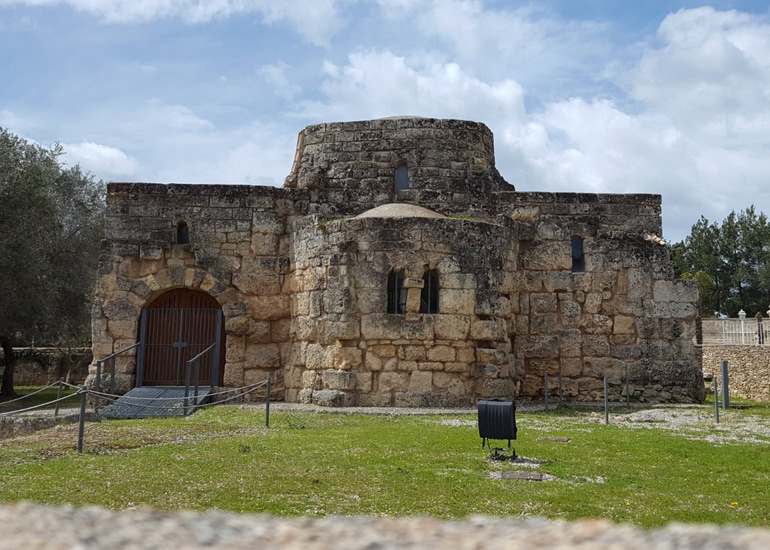
A never-ending story…. a visit that could last many years….
These are just a few of the museums and archaeological treasures that we recommend you to visit, but many other sites should not be missed, such as the Archaeological Museum of Brindisi with proof that the Brindisi area was inhabited since the Upper Paleolithic (12,000 years BC) to the Roman age with sections dedicated to epigraphy, statuary and underwater archaeology; the Jatta National Archaeological Museum in Ruvo di Puglia, a real house-museum which hosts many masterpieces in ceramics, both Attic and Italic; the Castro Museum which collects finds from the Paleolithic age, around 12,000 years ago, up to the sixteenth century, when Castro was the most exposed point on the border with the Ottoman Empire.
Apulia is a cultural treasure trove. We look forwarding to seeing you here!





